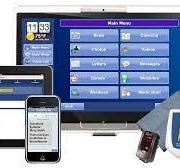GrandCare benefits all areas of elderly care
Caring for a loved one who is facing end of life is a difficult situation for all parties involved. Time or geographic constraints can sometimes prevent family members from being physically present, but modern technology is changing the way the nation looks at quality health care.
Knute Nelson, a nonprofit, Christian-based organization that specializes in senior care, has teamed up with local telecommunications providers such as Gardonville Cooperative Telephone Association (Brandon, Minn.) to offer an in-home technology solution that connects seniors and Hospice patients with their loved ones, caregivers and medical team.
Through the use of the GrandCare System, a simple touch platform enables in-home residents to view pictures, receive incoming messages, watch videos, listen to music and video chat with family. The system uses a variety of wireless activity and telehealth devices that also can alert designated caregivers by phone, email or text message if anything seems amiss.
Daphne Karpan, Knute Nelson palliative care manager, said the system has been particularly helpful and beneficial to the health-care organization’s Hospice clients, who generally have a one- to nine-month life expectancy. Being able to connect them with their loved ones at such a critical time has been a rewarding experience for all parties involved, she said.
Testing Out Telehealth Services
The GrandCare System requires an Internet connection to work. Because most of the affected patients are not existing customers, Dave Wolf, chief executive officer/general manager of Gardonville Cooperative Telephone, said that his team makes it a top priority to install the low-cost broadband connection “without a bunch of red tape.”
Karpan noted that Knute Nelson is only able to offer this service through the support of a Blandin Foundation grant. The private foundation is the state’s largest rural-based, rural-focused foundation that seeks to strengthen communities in rural Minnesota.
Karpan said hospice nurses are able to work with clients to set up Skype sessions and to upload pictures for families to share. In addition, the device can be programmed to monitor vital signs and activity. There are also sensors to alert caregivers if someone falls or needs to take their medicine.
“We have been proactively redefining the health-care paradigm over the last decade and have found great value in how technology helps to enrich the lives of our patients. With GrandCare, patients are able to become more involved in their own health care, stay living in their homes, and be connected to families and friends in meaningful ways,” said Mark Anderson, president/chief executive officer of Knute Nelson. “Partners and leaders in the field such as Dave Wolf … understand the value in delivering this technology. Making it available to their customers helps to spur economic development and vitality in our region—and, most importantly, adds significant value in the lives of our patients.”
Doing the Right Thing
Reflecting on the decision to partner with Knute Nelson on this initiative, Wolf said it was an easy decision to make despite the fact that it’s not a revenue generator. “These people are facing end-of-life,” he said. “It would require a one- to three-year triple-play package in order to break even at best. Everyone—the patient and their family members— is grateful and becomes loyal to the co-op for providing this service.
“There are 100 economic reasons not to get involved … but we have the means and the network already in place,” he said, explaining that Gardonville Cooperative Telephone is promoting the service as a low-speed data package that runs on 1 Mbps and doesn’t require those in home care or Hospice to sign a contract.
“Not everything has to be a slam-dunk,” Wolf said. “In this case, loyalty is a measurable outcome.”












